




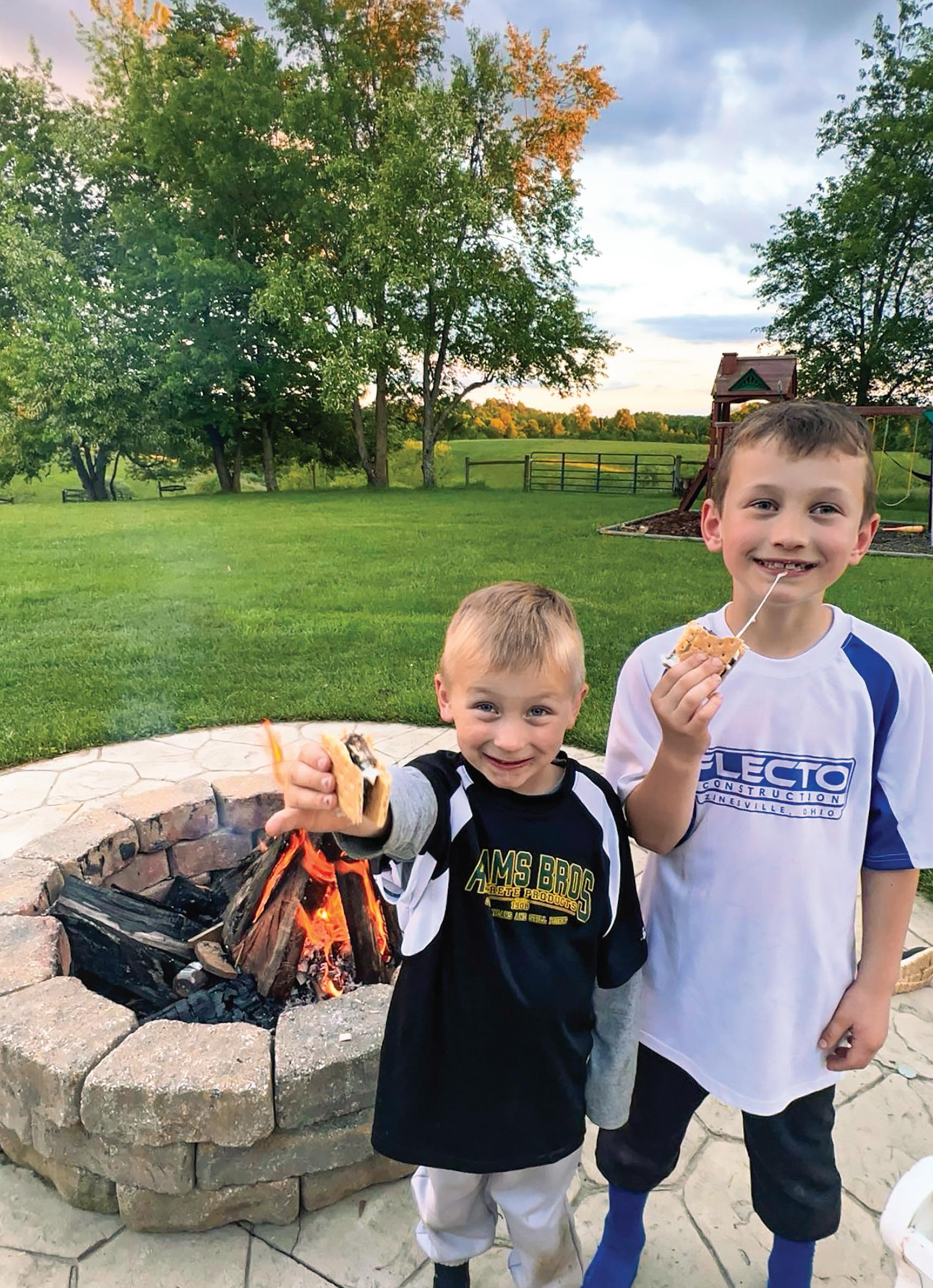













before you dig
to locate underground electric or other utility lines. This is a free service and it’s the law!
Before you buy a tree, look up and around. See any power lines? That’s your cue to plant far away—use the chart below as a guide.
Avoid planting shrubs and flowers around green transformer boxes and electric meters. Your co-op needs access for meters, and it’s safer to keep the space clear.
ohioec.org/purpose
Small-Tree Zone: Less than 25' tall and spread at least 25' from lines.
Medium-Tree Zone: 25'-40' in height and spread at least 40' from lines.
Large-Tree Zone: Larger than 40' in height and spread at least 60' from lines.

21 HEISMAN
The iconic coach and trophy namesake has a connection to Ohio that goes much deeper than Archie Griffin.
24 DOWNDRAFT
The 1986 Cleveland Balloonfest has been described as both a fiasco and a rousing success.
28 DRIVING IN CIRCLES
Love ’em or hate ’em, roundabouts work, and they’re here to stay.
30 NEXT GENERATION
Youth ambassador preaches co-op spirit to her peers at the Farm Science Review.
Cover image on most editions: Brothers Nash (6) and Ryder (8) Seamster enjoy s’mores in their New Concord backyard after an afternoon of baseball in this photo submitted by their mother, Natalie Seamster, a member of Guernsey-Muskingum Electric Cooperative. See more members’ pictures on page 36, and check out our recipes for some out-of-the-ordinary campfire treats beginning on page 12.
This page: Any fan of college football will recognize the familiar pose of the player represented on the trophy given each year to the best player in college football — but most probably don’t know that John W. Heisman, the trophy’s namesake, got his start in Ohio (photograph by Debby Wong/shutterstock.com).

Farming has long been the backbone of Ohio’s economy. Even if you don’t farm today, you likely have friends or family who do, or ancestors who once did.
Ohio’s electric cooperatives have a long history with the farming community. Years ago, rural residents (many of them farmers) worked together to bring electricity to their homes and towns, changing life in the countryside forever.
That same spirit of teamwork is still strong today and it’s one of the reasons we always look forward to events like the Farm Science Review, which will take place Sept. 16–18 at Ohio State University’s 2,100-acre Molly Caren Agricultural Center near London.
Farm Science Review is more than just a farm show. The event brings together farmers, families, and businesses to offer ideas to improve life on the farm. Yes, the equipment and technology on display is impressive — seeing all the high-tech tractors and machinery up close is reason enough to go. But visitors will also find health and safety information, farm management programs, even field demonstrations showing best practices in planting and harvesting, and lots more. A multitude of experts and vendors will be there, ready to answer questions about all the latest tools for the farm and home.
In short, it honors Ohio’s farming heritage — it’s a place to celebrate Ohio’s agricultural past, learn about what’s new, and get ideas for the future.
Most importantly, the Farm Science Review is for everyone, not just farmers. Whether you’re looking for the latest technology, wanting to connect with others, or just out to enjoy the sights of the farming world, this event is worth your time. It’s a strong reminder of how important agriculture is to all Ohioans.
September in Ohio always brings a welcome break from the heat of summer. As you plan out your month, I encourage you to set aside time for the Farm Science Review, and if you go, make sure to visit the Ohio’s Electric Cooperatives Education Center on Wheat Street. You’ll find energy-saving demonstrations, hands-on displays, and advice about using electricity safely and wisely. These resources are great for both your farm and your home. We’ll also have several activities for children, so bring them along.
As always, we’ll have plenty of popcorn.
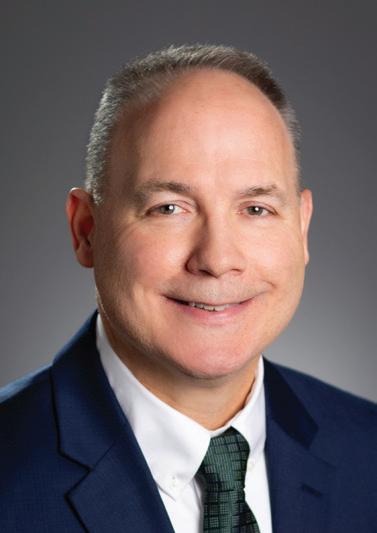
Farm Science Review is for everyone, not just farmers. It’s a strong reminder of how important agriculture is to all Ohioans.
6677 Busch Blvd. Columbus, OH 43229 614-846-5757 www.ohiocoopliving.com
Craig Grooms President & CEO
Caryn Whitney Director of Communications
Jeff McCallister Senior Managing Editor
Amy Howat Assistant Managing Editor
Neal Kindig Graphic Designer
Contributors: Colleen Romick Clark, Andrea Marchi Double, Getty Images, W.H. “Chip” Gross, Catherine Murray, James Proffitt, shutterstock.com, Mia Taylor, Damaine Vonada, and Margie Wuebker.
OHIO COOPERATIVE LIVING (USPS 134-760; ISSN 2572-049X) is published monthly by Ohio Rural Electric Cooperatives, Inc. It is the official communication link between the electric cooperatives in Ohio and West Virginia and their members. Subscription cost for members ranges from $6.96 to $8.64 per year, paid from equity accruing to the member.
POSTMASTER: Send address changes to editorial and advertising offices at: 6677 Busch Boulevard, Columbus, OH 43229-1101. Periodicals postage paid at Berne, IN 46711, and at additional mailing offices. Nothing in this publication may be reproduced in any manner without written permission from Ohio Rural Electric Cooperatives, Inc. All rights reserved. The fact that a product is advertised in Ohio Cooperative Living should not be taken as an endorsement. If you find an advertisement misleading or a product unsatisfactory, please notify us or the Ohio Attorney General’s Office, Consumer Protection Section, 30 E. Broad St., Columbus, OH 43215. Periodicals postage paid at Columbus, OH, and at additional mailing offices.

Power’s pain points: Co-ops push for transmission upgrades that significantly improve reliability. That investment, however, often can mean higher rates.
8
Pony show: A Tipp City family’s Mustang museum pays tribute to one of Ford Motor Company’s unsung automotive pioneers.
Paddlers’ paradise: Old Woman Creek estuary is a haven for nature lovers and kayak connoisseurs. But about that name...
12
Campfire treats: At a rustic spot where you pitch your tent or by your backyard fire pit, there’s something about a dancing flame that adds extra fun to these simple snacks.
17
News and other important information from your electric cooperative.
National/regional advertising inquiries, contact Cheryl Solomon
American MainStreet Publications 847-749-4875 | cheryl@amp.coop
Cooperative members:
Please report changes of address to your electric cooperative. Ohio Cooperative Living staff cannot process address changes.
Alliance for Audited Media Member
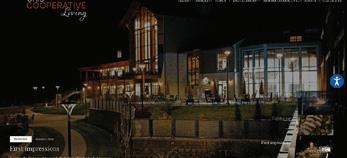
33
What’s happening: September/ October events and other things to do around Ohio.
36
12 10 8 4 36 33

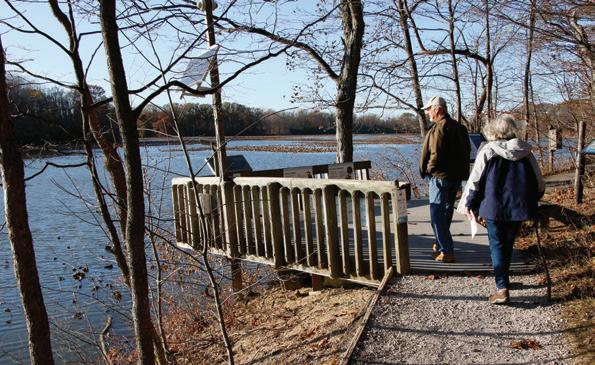
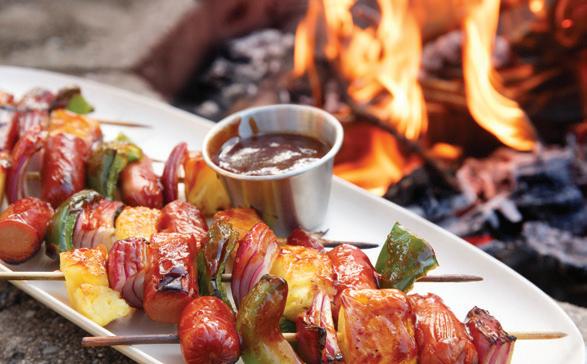

Campfire treats: Is there anything better around a campfire than s’mores? Enjoying hers, at right, is Kaylee Smith, daughter of South Central Power Company member Amy Smith.

Visit Ohio Cooperative Living magazine online at www.ohiocoopliving.com! Read past issues and watch videos about our articles or our recipes. Our site features an expanded Member Interactive area, where you can share your stories, recipes, and photos and find content submitted by other co-op members across the state.
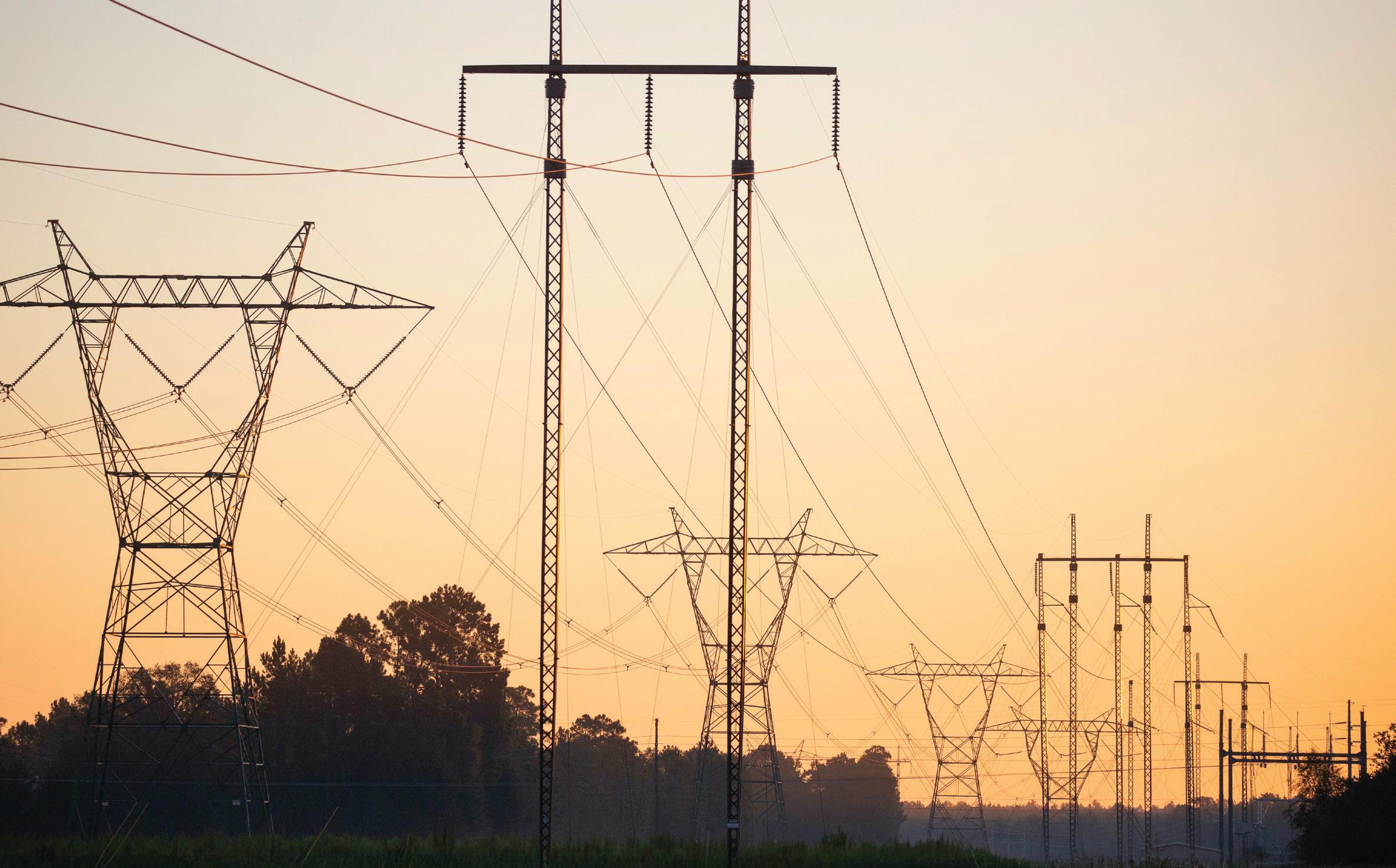
Co-ops push for system upgrades that significantly improve reliability. But that power comes at a price.
BY AMY HOWAT
Larry Kelly remembers a time, from the late 1990s into the mid-2010s, when any strong wind could cause him to lose power at his home near Graysville for a couple of hours — or longer.
“When there was a more serious storm, outages of eight hours were typical, and that could happen once a month or more,” Kelly says. “I went out of town for a week one summer and there was a long outage. When I came home, my refrigerator was like a biosphere. I tried everything — including skunk spray — to get rid of the smell. It took a box of activated charcoal with a fan for a week to save my refrigerator.”
Kelly knew that personnel from his co-op, Marietta-based Washington Electric Cooperative, were doing everything they could to provide reliable power for him and all of his neighbors in that area of Monroe County. The problem was that many of the outages were occurring before electricity even reached the co-op’s substations.
The problem wasn’t a lack of power generation — the Cardinal Power Plant and other assets of Buckeye Power, the co-op-owned generating company that serves Ohio’s

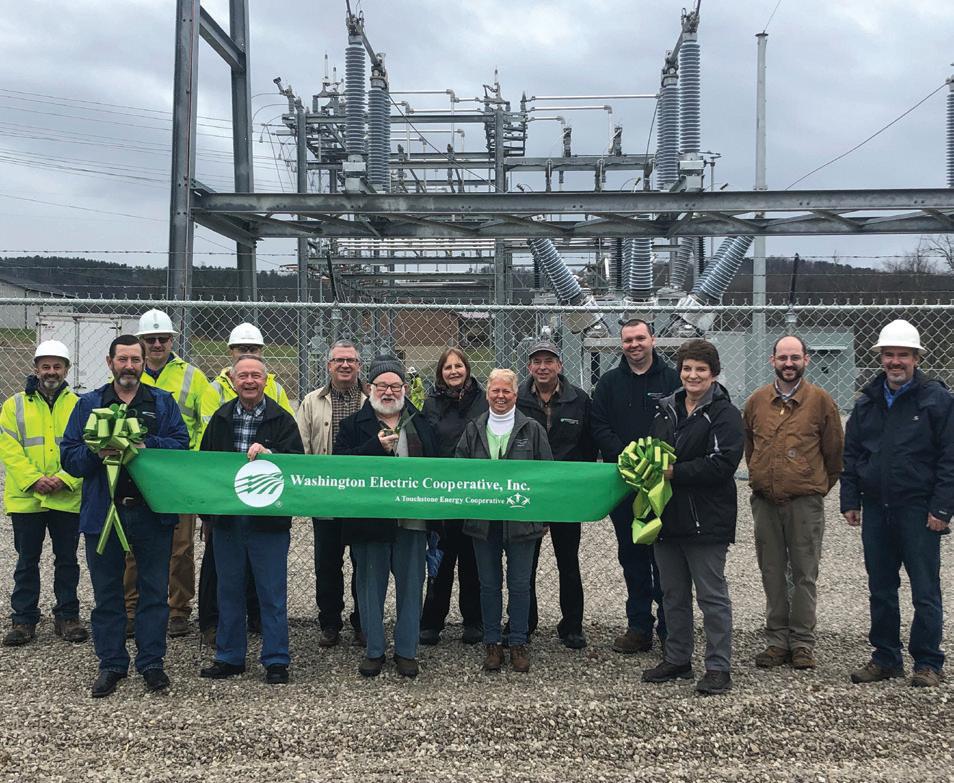
cooperatives, were producing plenty of electricity. And the problem usually wasn’t in the nearly 1,800 miles of Washington Electric’s lines that run from substations to members’ individual homes and businesses.
The problem lay in transmission, the movement of electricity between the power plant and the co-op along high-voltage lines that, for the most part in Ohio, are owned and maintained by investor-owned utility companies.
“Our local co-ops do their best to maintain their lines, but there are things that are beyond their control,” says Tom Schmidt, principal planning engineer for Ohio’s Electric
Cooperatives, the statewide trade and service organization that includes Buckeye Power. “Unfortunately, when transmission goes out, you’re talking about a whole substation, so it’s hundreds and hundreds of co-op members affected. These outages often occur during snowstorms or ice storms — the worst possible times — and all the co-op can do is wait for transmission to come back.”
In Kelly’s case, Washington Electric was reliant at the time on West Virginia-based Monongahela Power, which showed little interest in maintaining or upgrading the transmission infrastructure in the corner of Ohio it served. When American Electric Power purchased Monongahela’s assets in 2005, it faced a daunting task.
“The transmission system was low-voltage and had become antiquated,” says Jeff Triplett, Washington Electric’s general manager. “It was very unreliable. Our substations were among the worst delivery points in the state, in terms of number and duration of outages. They affected 500 or 800 people at a time, and this went on for many years. It was very frustrating for our members.”
To complicate matters, that area of southeastern Ohio, including large chunks of the Wayne National Forest, is hilly, densely wooded, sparsely populated, and generally a difficult and expensive place to build transmission infrastructure. (Monroe County has been called “The Switzerland of Ohio” because of its rugged terrain, which may have attracted its early Swiss settlers.)
Washington Electric and Ohio’s Electric Cooperatives worked with AEP on an extensive plan to improve reliability. AEP would replace old 23-kilovolt transmission lines with new 138-kV lines, and they would be networked — providing the ability to backfeed electricity from another direction if one transmission line went out. Washington Electric would build new 138-kV substations to transfer power into its local distribution system.

This comprehensive rebuild required substantial investments — in time, effort, and money. AEP spent some $250 million on new transmission lines, replacing dilapidated wooden poles with durable steel structures. The costs for such upgrades are recouped through higher rates charged to consumers, Schmidt says. Those rates are federally regulated, and for the past 10 to 15 years, regulators have been granting rate increases that have made it feasible and even appealing for the investor-owned utilities to make such improvements.
Although the topography around Firelands Electric Cooperative in New London — plains that are friendly to corn and soybean fields — may not be as rugged as the forested hills around Washington Electric, Firelands has also experienced transmission troubles.
“For about 50 years, we had about half of our substations, serving 60% of our members, on transmission lines that dead-ended at one of our substations,” says Don Englet, Firelands’ general manager. Such “radial feeds” lack a loop connecting to an alternate transmission source, so if the incoming line goes down, everyone on the substation loses power.
Ohio’s Electric Cooperatives’ power transmission group negotiated with transmission provider First Energy to loop one substation to another in 2019, providing a two-way feed to about 40% of members. But the co-op’s largest substation, in New London, was still on a radial feed with no backfeeding option. “If we lost that transmission feed, 1,800 members were left in the dark,” Englet says.
In June of 2023, that feed was off for nearly 47 hours. “We communicate with members that although we own the generation of electricity (through Buckeye Power), we don’t own the transmission,” Englet says. “But that doesn’t make it any less frustrating for them when the power is out.”
So Firelands and OEC negotiated with First Energy and AEP, which were working to interconnect their transmission systems, to place the tie point at the coop’s New London substation. Once the project is complete, the station will have transmission feeds from both companies, so if one goes out, the other can still provide service.
“This will benefit us tremendously,” Englet says. “We’ve seen improvements on our northern substations since 2019, and this will be another huge boost for reliability.”



Continued from page 5
Co-ops pass transmission charges through to members at cost, usually noted on electric bills within a generation and transmission, or G&T, line item. (The “G” portion goes to the electric producer — Buckeye Power for Ohio co-ops — and those rates have stayed relatively stable, Schmidt says.)
“Transmission cost is a real concern,” Triplett says. “It’s gone up astronomically, and members notice it on their bills. We’ve been lucky that we can say although those costs are going up, at least our members are seeing results. They notice the difference in improved reliability.”
The need for transmission infrastructure continues to grow, Schmidt says, driven by ever-increasing demand for electricity. That means transmission costs will keep growing as well.
When most co-op members in Ohio look at their electric bills, they may note a charge for generation and transmission — separate from what they pay the co-op to build, maintain, and manage local distribution of electricity. It’s usually a significant portion of the bill.
But where does it come from?
Electric cooperatives in Ohio collectively own and are members of Buckeye Power, a generation and transmission cooperative, or G&T, they formed in 1959 to get them the power that keeps their members’ lights on.
While some of the country’s 64 G&Ts both generate and transmit the power they deliver to their member co-ops, others may simply purchase wholesale power on the open market and/or pay to use high-voltage transmission systems owned by others to deliver it.
Buckeye Power owns ample generation resources — the coal-fired Cardinal Power Plant, two natural gas peaking plants, and a variety of renewable sources — to produce plenty of reliable power and at the same time keep it as affordable as possible.
“We have sufficient generation to meet members’ needs now and in the foreseeable future, even with the significant load growth we’re expecting,” says Craig Grooms, president and CEO of Ohio’s Electric Cooperatives (the statewide organization that includes Buckeye Power). “Owning and operating our own generation, depending on ourselves rather than external suppliers, allows us to control that part
Ohio’s electric cooperatives, both locally and through the statewide group, will continue to advocate for investments that help co-op members and rural areas — not just those that feed more data centers in central Ohio.
“We have several active projects in development,” Schmidt says. “A lot of times, we recognize costs are going up, but we know we stand to benefit greatly from those investments. We’re looking for the same success we had with Washington Electric, and applying it elsewhere.”
Larry Kelly, for one, appreciates the improved reliability to the remote area he calls home.
“Today, outages are so doggone rare,” he says. “I’m very appreciative of how far they’ve come and how good the service is today.”

of our costs, for the most part, and insulates us from a lot of price volatility.”
The G&T’s power delivery group then works with companies that own the high-voltage lines in the state to coordinate transmission of that power to the local distribution co-ops.
That’s where co-op members have seen the most significant increases in their bills lately.
Ohio’s transmission infrastructure is mostly owned by investor-owned utilities like AEP, First Energy, AES, and Duke Energy, which charge transmission fees. (A few local co-ops in the state own some transmission lines as well.)
“We arrange for transmission service, buying capacity on the transmission grid,” Grooms says. “In return, we expect good operations, good service, and good reliability, and we make sure those partners are fulfilling their obligations.”
At the same time, Grooms says, co-ops advocate for transmission improvements when they’re needed.
“Obviously, those upgrades cost money,” he says. “We recognize that some of the investments that benefit co-op members most will result in higher transmission costs.”
It’s important to note that, just like each of Ohio’s 24 local distribution co-ops, Buckeye Power is a not-for-profit entity.
“The ‘G’ and the ‘T’ are provided at cost,” Grooms says. “When that shows up on members’ bills, it’s a straight passthrough. There’s no mark-up and no profit for the co-op.”



















An exploration of 15 ports of call, with guided excursion options at each
All onboard meals and our signature evening cocktail hour
Full enrichment package with guest speakers and nightly entertainment
All tips and gratuities



Immerse yourself in the sights, sounds, and tastes of New England. From quaint island villages to the breathtaking beauty of the coastline, summer in New England is a truly delightful experience. Discover the region’s rich maritime heritage, savor a traditional Lobsterbake, and marvel at grand mansions of the Gilded Age. Return to the comfort of your onboard sanctuary and bask in the warm camaraderie of fellow guests and crew.

Most people who casually drive past the (mostly) nondescript white barn along U.S. 40 in rural Miami County have no idea about the automotive history displayed inside.
Even the sign proclaiming the structure as the Halderman Museum Barn doesn’t give much of a clue to those who aren’t in the know (though the familiarlooking 6-foot-tall insignia of a galloping pony that adorns one side of the building is a hint).
For car enthusiasts from all over, however, it’s almost considered hallowed ground. The museum was created by and remains a lasting tribute to Gale Halderman, whose grease-pencil sketch he made as a low-level automotive designer eventually became the iconic Ford Mustang.
In truth, Halderman never envisioned a full-blown museum on the family farm near Tipp City where he grew up, says Karen Koenig, Halderman’s daughter, who is now the curator. After he retired from the Ford Motor Company in 1994, he merely wanted to display some Mustang and other Ford memorabilia in his man cave at one end of the barn. He enjoyed greeting visitors there and sharing stories about his career designing cars until the day he died in 2020.
Halderman had spent much of his childhood filling all the paper he could find with sketches of vehicles of all sorts while his parents and grandparents ran the

farm (and helped to educate neighbors about the new cooperative — now Pioneer Electric Cooperative — that had started bringing electricity to the area when he was 3). He went on to attend the Dayton Art Institute, and even before he graduated, talked his way onto the design team at Ford.
One day in the early 1960s, while working on the Galaxie project, executives ordered all the company’s designers to come up with concepts for a sleek and sporty yet affordable car that would appeal to younger drivers — male and female alike.
“Dad went home at 11 that night and sat down at the kitchen table with grease pencil and paper,” Koenig says. “He turned in his designs by 8 the next morning.”
One of Ford’s vice presidents at the time, Lee Iacocca, studied dozens of submissions before settling on Halderman’s design, which laid the foundation for the new model. Iacocca decided it would be dubbed “Mustang,” to be unveiled at the 1964 New York World’s Fair.
The Mustang’s success was immediate and unparalleled — more than 22,000 vehicles sold the first day they were available, and nearly a half-million the first year. It is the longest continuously produced Ford vehicle, with more than 10 million sold, and also now has an electric version, which was introduced in 2018

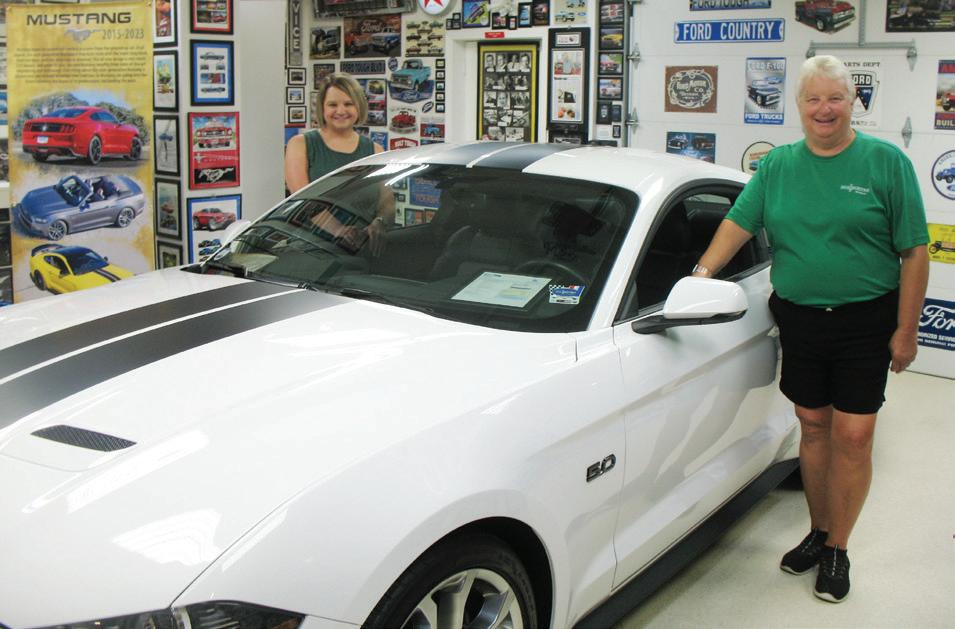


Ford’s triumph propelled Halderman to a string of accomplishments in the cutthroat world of auto design, and his career with the company lasted 40 years.
As he spent more and more time in the man cave with his other retired friends, surrounded by automotive history, the memorabilia collection grew, and, Koenig says, her father’s displays quickly spilled into other parts of the barn.
“Dad retired in 1994 and dedicated his remaining years to preserving the Mustang legacy and his role in its creation,” Koenig says. In 2014, the family decided to officially open the space as a museum. “The documentary A Faster Horse was released when the model was turning 50 years old and really sparked renewed interest in the Mustang,” Koenig says. She spent an entire winter organizing the displays.
Many of Halderman’s designs adorn the walls. In addition to all things Mustang, there are sketches of the Galaxie, the Lincoln Town Car, and Ford trucks, which he also worked on during his career. The displays also include vintage signs, posters, toys, and more than 1,500 diecast vehicles (car enthusiasts often donate unique bits to the museum, and the family is always on the lookout for new items to display). The walls are filled with photos of Ford executives with whom Halderman worked as well as those of fellow Mustang Hall of Fame honorees.
In addition, Halderman designated one room to house part of his daughter’s massive camera collection. Each of the 500-plus cameras is properly identified and dated.
The barn has undergone many changes over the years, including an addition at the back to accommodate car clubs and organizations. The grounds host numerous cruise-ins and special events, like the annual gathering held each June to commemorate Halderman’s birthday. His granddaughter, Lauren Koenig, coordinates museum events and activities.
“After his death in 2020, we decided to continue his legacy by keeping the museum open. It has changed in the five years since dad died,” Koenig says. “We have added more memorabilia, and I am certain he would approve.”
The Gale Halderman Barn Museum, 6476 U.S. 40, Tipp City. Hours are by appointment — request at www.haldermanmustang.com. There is no admission charge, but donations are accepted.


Old Woman Creek is a haven for nature lovers and kayak connoisseurs. But about that name...
If you enjoy water paddle sports such as kayaking and canoeing, but would rather not deal with the challenges and dangers of whitewater rapids, I have just the place for you. It has a spectacular view of Lake Erie, and belted kingfishers, great egrets, and other waterbirds fly by as you float along the 2.5-mile water trail. If you’re more of a landlubber, there are half a dozen hiking trails available there, too.
Old Woman Creek National Estuarine Research Reserve is located a mile east of Huron, along State Route 6. It’s owned and operated by the Ohio Department of Natural Resources, and it’s also a state nature preserve, dedicated in 1980. Best of all, it’s open to the public year-round — free of charge.
Freshwater estuaries are areas where creeks or rivers meet and mix with chemically distinct larger bodies of water (in this case: Lake Erie). “Old Woman Creek is the best example of a large barrier beach estuary in Ohio,” says Janice Kerns, the reserve’s manager.
Kerns grew up in a suburb of Columbus, and says she had an intense interest in the outdoors, even as a kid.
“I took a summer course in marine biology during high school, and that experience really helped guide
my future undergrad and postgraduate studies and ultimate career path,” she says.
Kerns oversees a staff of about a dozen other scientists and employees involved in education, research, stewardship, and technical training. The team works from the Mike DeWine Center for Coastal Wetlands Studies, which also houses the reserve’s public visitor center. “We have a tradition at Old Woman Creek of mentoring early career professionals by providing internships and summer jobs for the next generation of coastal researchers and decision-makers,” Kerns says.
Anyone who owns a canoe or kayak is welcome to enjoy the paddling opportunities on Old Woman Creek any time of year — but if you don’t happen to own such a watercraft, Old Woman Creek has you covered with a variety of events and amenities.
“We offer free guided kayak and canoe tours of the estuary,” Kerns says. “We have a fleet of canoes and kayaks, paddles, and life jackets visitors can borrow while on guided trips.” Tours are given every other Wednesday and Saturday during the summer. Dates and registration information are available at www.ohiodnr.gov/oldwomancreek.
Another must-do activity while visiting Old Woman Creek is taking a leisurely stroll along the sandy, quarter-mile-long barrier beach that borders Lake Erie. On any particular day or season of the year, you could experience lake conditions ranging from totally calm to waves crashing ashore — or anything in between. You might also catch a glimpse of a bald eagle soaring along the lakeshore searching for fish.
“The best time of year to view eagles here is during their breeding season, from winter to late spring,” Kerns says. “There is only one active eagle nest at OWC this year, but many eagles use the estuary as a gathering area — last December staff members and I counted some 30 eagles perched in the trees surrounding the marsh.” She says that sighting included a mix of mature birds, which have the striking white head and white tail feathers, and younger birds, which are mainly dark brown in color. “Viewing that congregation of bald eagles all at the same time was truly spectacular,” she says.
Of course, you must be wondering just how Old Woman Creek got its odd name, which dates back at least to the late 1700s. But it’s kind of complicated; at least two different legends exist about its origin. One says it was named for an elderly Native American woman who, grieving for her slain daughter and son-in-law, threw herself into the creek and drowned; another claims pioneers simply noted a friendly older woman whose creek-side residence was a point of reference for early settlers.
Unfortunately, neither story has been substantiated — and likely never will be — so my advice is to simply choose whichever you like best.


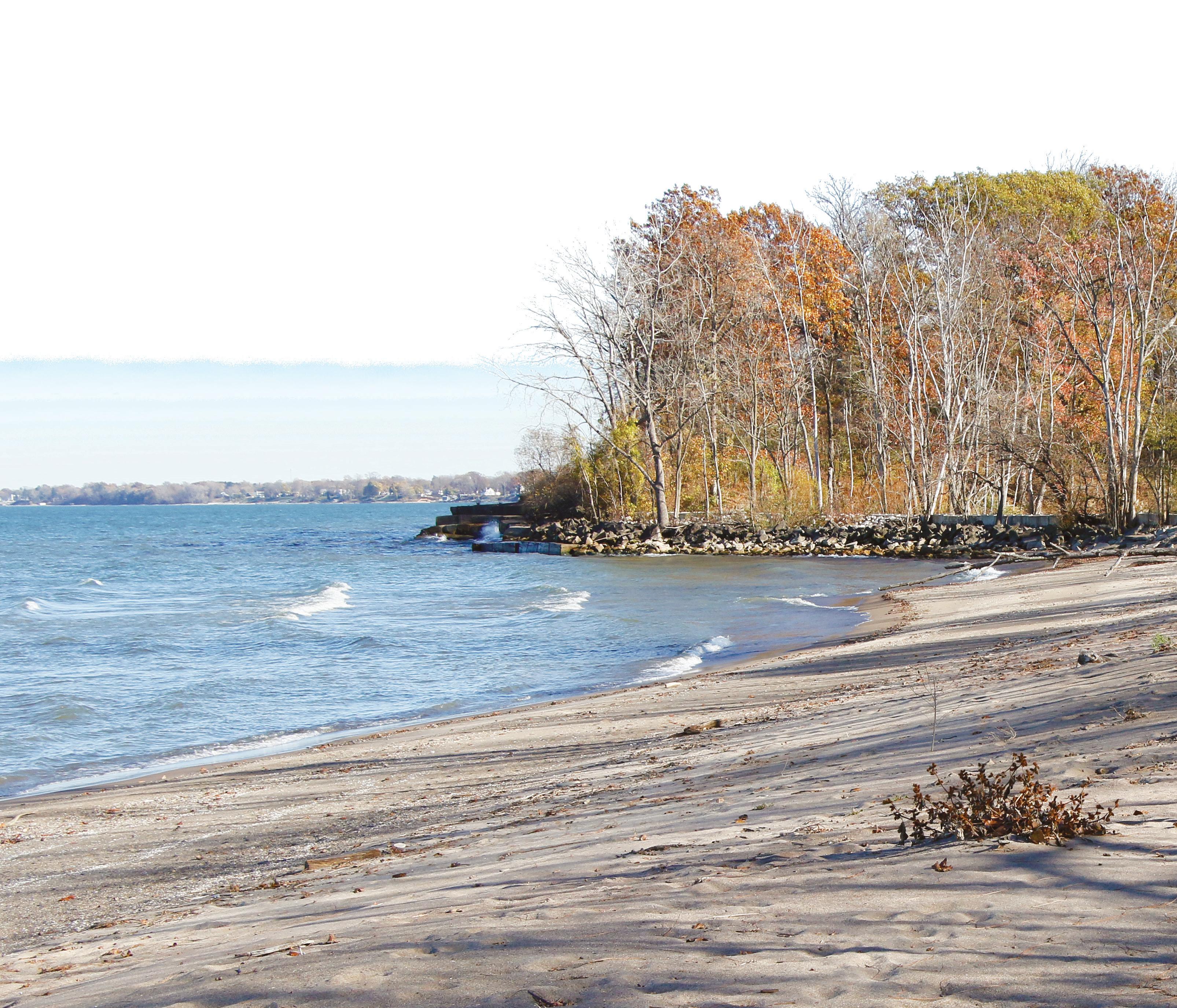
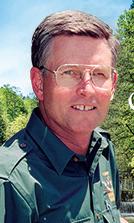
W.H. “Chip” Gross is Ohio Cooperative Living’s outdoors editor. Email him with your outdoors questions at whchipgross@gmail.com, and be sure to include “Ask Chip” in the subject of the email. Ask chip!
Your question may be answered on our website!
At a rustic spot where you pitch a tent or by your backyard fire pit, there’s something about a dancing flame that adds extra fun to these simple snacks.
Popcorn is light to pack and endlessly versatile. There are multiple ways to pop popcorn over a campfire, from a castiron pot to simple aluminum-foil packets. Try this colander method, which doesn't require any oil.
Prep: 5 minutes | Cook: varies | Servings: 4
2 to 4 tablespoons popcorn kernels 1 to 2 spoonfuls clarified butter (ghee)* salt (pink Himalayan salt shown)
One tablespoon of popcorn kernels will yield about 2 cups of popped popcorn, so estimate how many cups your stainless-steel colander can hold, then place no more kernels than will fit once popped in the bottom of the colander. Cover with a fire-safe lid or seal the top with aluminum foil, tenting it a bit if possible. Place colander on the fire’s grill, just outside the reach of flames. It can require quite a bit of heat for the popcorn to start popping, so if it doesn’t begin to pop after 5 minutes, build up the fire to increase the heat.
Meanwhile, place clarified butter in a small fire-safe pot. Set close to the edge of the fire to melt. Once popping slows, use thick fire-safe gloves or tongs to carefully remove colander from fire and lift lid/foil. Pour popcorn into serving bowls, drizzle with melted butter, and sprinkle with salt.
*Clarified butter (ghee) can be found in the pantry section of the grocery store. Unlike regular butter, clarified butter has been heated to remove water and milk solids so it won't soak into the popcorn and leave it soggy. As an added bonus, it stays solid at temperatures below 87 F, making it easy to pack in spring and fall. Liquid butter toppings found in the popcorn aisle will also work.

Check it out!
See videos of some of our mouthwatering recipes being prepared at www.ohiocoopliving.com
You’ll want to do a little advance work before heading to the campfire for this one.
Prep: 15 minutes | Cook: varies | Servings: 4
2 tablespoons thick barbecue sauce
1 tablespoon ketchup
½ tablespoon soy sauce
½ teaspoon rice wine vinegar
¼ teaspoon chili powder
4 metal or bamboo skewers
9 hot dogs, quartered
1½ cups pineapple chunks
small bell pepper, cut into chunks small red onion, cut into chunks
Before heading to the campfire, mix together the barbecue sauce through chili powder in a packable container with lid. If using wooden skewers, soak them in water for at least 30 minutes before assembly to prevent burning. Build skewers by alternating hot dogs, pineapple, peppers, and red onion. For metal skewers with wooden handles: Hold above the flame, rotating regularly. For wooden skewers: Lightly coat both sides of kabobs with nonstick cooking spray. Place an inch or two apart on a metal grate above the fire. When the first side is roasted, use gloves or tongs to flip kabobs and roast the other side. Brush with sauce and enjoy!
Prep: 5 minutes | Cook: varies | Servings: 4
4 bananas
aluminum foil spoons
Suggested Toppings: trail mix, granola, fresh fruit, dried fruit (jam works, too!), chopped nuts, peanut butter, chocolate chips, chopped chocolate bar, mini marshmallows, torn marshmallow pieces, crumbled cookies or other baked goods.
Banana boats are incredibly simple to make. Cut a slit lengthwise down the middle of the peel on the concave side — not all the way through, but until the tip of your knife just grazes the peel on the other side. Pull the peel and banana slightly apart. Place banana diagonally, pointed ends up, in the middle of a sheet of aluminum foil and mound desired toppings in and around the sliced opening of the banana. Pull sides of foil up so the corners are touching, then crumple-roll the foil down just before touching the toppings, then crumple-seal the short sides as well. Repeat with the other bananas. If your fire is blazing bright and hot, place boats crimp-side up onto a grill grate to heat. If your fire is down to glowing embers, nestle the pouch inside the embers. Check after 2 minutes and adjust cooking spot if needed (closer or further from heat). When cooked to your likeness, remove from fire with tongs or gloves, place on a heat-safe plate or bowl, and carefully pull back foil. If banana is steaming, let sit for a minute to cool, then eat with a spoon!


Whether you need a new garage, hobby shop or storage for your RV and outdoor lifestyle, Morton Buildings’ post-frame construction protects your valuables in a structure that’s better looking, longer lasting and low maintenance.
Every building is engineered to meet your specific needs and reflect your style, with endless layout and finish options for every budget, size and use.
Backed by a leading industry warranty and decades of experience, Morton delivers form, function and quality from concept to completion.
Start your next building project and see how Morton buildings are built stronger, last longer and look better at mortonbuildings.com

A pie iron is a campfire cooking tool consisting of two cast-iron plates hinged together with long handles. They typically come in two sizes: 4x4 and 8x4 inches (shown).
Prep: 10 minutes | Cook: varies | Servings: 4 nonstick spray spreadable butter or margarine
8 slices of bread (white, Italian, French, or sourdough)
1/3 cup pizza sauce
8 ounces Italian blend cheese pizza toppings of your choice (pepperoni, banana peppers shown)
Open pie iron and lay both sides on a flat surface. Coat the insides with nonstick spray. If necessary, cut bread slices to fit the size of the pie iron. Butter the outside of one bread slice and place butter-side down in pie iron. Spread sauce on top, then sprinkle cheese and add toppings. Butter outside of another bread slice and place on top.
Close pie iron, keeping bread and toppings tightly inside while aligning the two plates. Lock handles together with the metal S-hook. Pick up pie iron by both handles and scope out a spot in the campfire — low down with a mix of embers and flames will provide even heat and toast the bread. Ensure the iron is stable and handles are well outside the fire before stepping away.
Cook time varies. Be prepared to check on the pie’s progress with heat-safe gloves and a pair of tongs at about 5 minutes. The goal is evenly toasted bread on both sides, with steamy melted cheese inside. If the butter and cheese are melted but the pie isn’t toasting, move it to an area with direct flame. If the bread is toasted but cheese isn’t melted, move down to the embers. If only one side is toasted, flip it so the uncooked side is closest to the heat. Just as with grilled cheese on the stove, the second side cooks faster than the first.
Once toasted, carefully remove from fire and place on a heat-safe surface. Unlock the S-hook and slowly open the iron. With tongs, transfer pie to a plate. It’ll be HOT! When using an already-hot pie iron to make another pie, expect the cook time to be less than half of the first pie.




Did you know that farmers helped bring electric cooperatives to life in America? In the 1930s, investorowned utilities were unwilling to serve many rural areas, so farmer-based cooperatives decided to take matters into their own hands. They applied for government funding to bring electricity to their communities, leading to the creation of the Electric Cooperative Corporation Act in 1937. Thanks to their efforts, more than 90% of U.S. farms had electricity by 1953.
Without farmers, we might not be here, and we are proud to continue powering and connecting many of our communities' farms and farming families today. National Farm Safety & Health Week is an important reminder that agriculture can be a dangerous industry, and it is incredibly important to stay alert and aware of potential hazards — from the barn to the road to the fields.
Utility Safety Reminders:
• Regularly review potential hazards around the farm and make sure you know where utility equipment is located. Call 811 for help identifying underground utility lines.
National Farm Safety & Health Week is September 21-27.
• While operating machinery, maintain 360-degree awareness. Leave a wide berth around utility equipment like power lines, transformers, or propane tanks, and use spotters in tight spaces to help you avoid contact.
• Never attempt to raise, move, or clear a power line — even if it's in your path. Find a way around for tall equipment, and call us and 911 if you encounter a downed or damaged line.
• Trust your nose! Both natural gas and propane contain additives that smell like sulfur or rotten eggs to help make leaks noticeable. If you think you smell gas, close your gas shutoff valve, extinguish any flames or ignition sources, and evacuate the area immediately. Then, call our emergency hotline at 866-946-6600 and/or contact your local fire department.
To All Consolidated Members: Please help keep our local farmers and their families safe this season. When you encounter farm equipment on the road, slow down, be patient, and give them plenty of room. Some equipment makes wide turns, so stay alert and be prepared to adjust.
To Our Farmers: We wish you all a safe and bountiful harvest season. We are so proud to play a part in helping you enrich our communities and feed the world.

Experience the cooperative difference: world-class internet backed by personal, responsive service.
Check out our plans and service availability at consolidated.coop/fiber.


As summer winds down, now is a great time to take stock of your home’s heating system. Here are a few things you can do now to help you save energy and money this winter:
• Get an Inspection: Annual heating system inspections can help you catch minor issues before the heating season begins, preventing breakdowns or expensive emergency repairs over the winter. In addition, well-maintained systems run more efficiently, helping you use less energy.
• Compare Your Options: Not sure if your heating system is right for you? Compare the estimated annual costs of different heating methods using our free, online Heating Comparison Calculator. It can even help you see how much you could save by adjusting your thermostat a few degrees.
• Re-Evaluate Your Space Heaters: Space heaters can provide a cozy boost on those extra cold days, but they might be using more energy than you realize. Check out our free Space Heater Calculator to estimate your monthly costs based on how many space heaters you have and how frequently you use them.
• Seal Up Your Home: Check for drafts around windows and doors, and use caulk or weatherstripping to seal up any gaps. This will help stop the cold air from coming in, keeping your home warmer and helping your heating system run for less time each day.
Our Energy Resource Center is full of free calculators, tools, and resources to help you make your home more efficient. Visit our website’s Energy Efficiency tab to learn more or contact us for a conversation. We would love to help you find ways to save before cold weather sets in!

USE YOUR CO-OP CONNECTIONS CARD TO SAVE AT LOCAL BUSINESSES
Visit connections.coop to see all local and national offers. Thousands of members also save each year on pharmacy discounts! Need a replacement card? You can download one on the connections.coop site or call our office and we will mail one to you.
Consolidated Cooperative is here to serve you. Please contact us if you have any questions.
CONTACT US
24-HOUR EMERGENCY
SERVICE: 800-421-5863 service@consolidated.coop www.consolidated.coop
MAIN OFFICE
5255 St. Rte. 95 Mount Gilead, OH 43338
DISTRICT OFFICE
4993 St. Rte. 521 Delaware, OH 43015
OFFICE HOURS
7:30 a.m.–4 p.m.
BOARD OF TRUSTEES
Michael Struck, Chair
Mike Schuster, Vice Chair
Mary Fuller, Secretary
Michael Huston, Treasurer
Tim Bachelder, Asst. Secretary
Don Breece
Megan Forman-Karbler
Doug Loudenslager
Larry Roof
HAVE A STORY SUGGESTION?
Email your ideas to: editor@consolidated.coop
GRAPHIC DESIGNER
Stephanie Daniel
COVER PHOTOGRAPHY
Morgan Mellen
We have experienced some extended, extreme heat this summer, which can lead to significant increases in energy use. If you need help with your summer energy costs, there is still time to apply for assistance through Ohio’s Home Energy Assistance Program (HEAP).
HEAP’s Summer Crisis Program offers utility assistance to income-eligible households who need some extra help staying cool — especially in cases where age or medical conditions make excessive heat dangerous. Qualifying applicants can receive a one-time benefit of up to $800 toward their electric bills, assistance with central air conditioning repair, or an airconditioning unit and/or fan.

Dual-fuel systems — $600
The Summer Crisis Program is open through September 30. Visit
or call
to learn more and check your eligibility.
Geothermal heat pump systems — $800
Electric water heater — $250
Heat pump water heater — $400
ENERGY STAR ductless mini-split — $600
Electric vehicle level 2 charger — $250
ENERGY STAR refrigerator — $100
Smart thermostat — up to $150
ENERGY STAR freezer — $100
ENERGY STAR central air unit — $150
*Rebates are given as credits on your electric bill. Call us for rebate information!
• Member Engagement provided updates on efforts that support member satisfaction, including increased participation in Outage Alerts and InControl Prepay. So far this year, the team has processed 138 rebates, partnering with Ohio’s Electric Cooperatives to return $31,039 to our members.
• Amanda Pridemore, CFO, discussed key financial information and processes, providing important education for new trustees.
• Tim Applegate, COO, reported Consolidated Fiber’s process. The fiber team and contractors have completed the first group for the Delaware Expansion Partnership, and they are continuing construction into the northern portions of our service territory.
• Trustees and staff went over sponsorship guidelines and processes that help ensure Consolidated continues to invest in the communities we serve in an equitable, impactful way.
The iconic coach and trophy namesake has a connection to Ohio that goes much deeper than Archie Griffin.
BY DAMAINE VONADA AND JEFF MCCALLISTER

Most college football fans in the Buckeye State hear the word “Heisman” and think immediately of the six Ohio State University players who have won the sport’s most prestigious award — most notably, perhaps, of Archie Griffin, still the only player to win the Heisman Trophy twice.
Some might also know that five other Heisman winners were born in Ohio (and that doesn’t include 2019 winner Joe Burrow, who played for Athens High and briefly attended OSU but was in fact born in Iowa).
But with the approach of the 90th anniversary of the first award in 1935, only the most trivia-minded will know the famed trophy’s true Ohio connection.
John W. Heisman himself, the renowned innovator and Hall of Fame coach — the award’s namesake — was born in Cleveland in 1859. And though he grew up in
Titusville, Pennsylvania, and played football for Brown University and the University of Pennsylvania, his first coaching jobs were at Oberlin College in 1892 (a season in which the Yeomen beat Ohio State not once but twice, by a combined score of 90–0) and Buchtel College, which is now the University of Akron.
“John Heisman was a pioneer and one of the most important names in college football,” says Denis Crawford, a historian and exhibit designer at the College Football Hall of Fame in Atlanta. “Pop Warner is top level; Walter Camp is an all-American. But Heisman is a name you’re going to remember for as long as they give out this award.”
The Heisman Memorial Trophy is presented annually in December to the nation’s outstanding college football player. When it was first awarded by New York











City’s Downtown Athletic Club in 1935, to University of Chicago running back Jay Berwanger, it was called simply the DAC Trophy. The following year, however, its name was changed to honor the club’s late athletic director, who had overseen the creation of the award: none other than the retired coaching legend, John W. Heisman, who died on October 3, 1936.
Why did Heisman deserve that honor, one that has not only withstood the test of time, but becomes more prestigious with each passing year? In a word, says Crawford, excellence. Some of Heisman’s “innovations” have become the most basic elements of today’s game; without them, it’s unlikely that college football would be the exciting, entertaining spectacle it is today.
He was the first, for example, to start offensive plays with a snap from center and the first to have players shift positions before the start of the play. He designed the earliest version of the reverse, a doublehandoff play designed to get the defense moving the wrong way; his “hidden ball” play was basically an extremely well-executed precursor to the fake handoff. And while he didn’t actually invent the forward pass (it was first used by accident in a game he was scouting), it was only through his advocacy that the play became legal in 1906. He even invented the practice of posting the score, down, and yards to go on a scoreboard.
During the offseasons, Heisman managed a summer stock theatrical company and traveled around the South giving performances.
John M. Heisman, the coach’s great-nephew, remembers returning home for a holiday visit in 1972 and finding his father, William, with travel trunks full of old manuscripts, newspaper clippings, and photographs.
A minister in Rhinelander, Wisconsin, had found the trunks, packed them and their contents in protective plastic, and shipped them to their owner’s nearest living relative. The trunks had belonged to the legendary coach, who had been married to a Rhinelander native and so was laid to rest in the northeastern Wisconsin town.
“When I was growing up, my father told me stories about my [great-] uncle John and used them as life lessons,” John says. He spent the entire next summer sorting and reading the contents, but in the fall of 1973, he went back to Ohio State to finish his degrees, and the trunks went to the back burner.
Fast-forward to 1984 , when John was settled in Toledo and decided to return to the contents of the trunks. He wrote more than 400 pages, whittled away at the book, and polished it. A friend connected John with book publisher Simon & Schuster and introduced him to Mark Schlabach, an investigative reporter and bestselling author, who helped him frame and flesh out its narrative.


His early success at Oberlin drew the attention of some powerhouse teams in the South, and he was hired to coach the Alabama Polytechnic Institute (now Auburn University) in 1895 and at Clemson five seasons later. His most prolific period was during his time at Georgia Tech, where he arrived in 1904. He stayed for 16 seasons, turning the school into a national football powerhouse whose 1915, 1916, and national champion 1917 teams were unbeaten.
One of the wins in 1916, a 222–0 triumph over Cumberland, was said to be revenge for an earlier 22–0 win by the Cumberland baseball team over the Heisman-coached Georgia Tech team. It remains the largest margin of victory in college football history.
Published in 2012, Heisman, the Man Behind the Trophy is still in print. It not only covers the coaching career of his great-uncle, but also tells stories about some of the coach’s other passions — for example, Heisman also was a Shakespeare enthusiast, actor, and theater producer who appeared in dozens of plays during and after his coaching career, many to rave reviews.
“I appreciate being able to tell his story,” John says. “Everybody is gaga about the trophy, but there is so much more Americana in Coach Heisman’s story. What happened before the Trophy was much more important.”

The 1986 Cleveland Balloonfest has been described as both a fiasco and a rousing success.
BY W.H. “CHIP” GROSS
The 1980s were tough economic times for Cleveland, the Buckeye State’s second-largest city. To a growing number of Americans, the Forest City was better known as the “Mistake by the Lake.” The embarrassment of the Cuyahoga River catching fire — more than once, and as recently as 1969 — due to pollution was still fresh in the city’s collective memory.
As a result of the decades of bad press, municipal leaders in 1986 were looking for a way to make Clevelanders proud of their city once again — to hopefully kick-start a general spirit of renewal.
They ultimately decided on a balloon release. But not just any balloon release; they wanted an event on a grand scale. The aggressive goal was to simultaneously release 1.5 million helium-filled latex ballons, setting a new world record that would be recorded in The Guinness Book of World Records.
Organizers went all-out for what was dubbed Balloonfest ’86. They hired noted Los Angeles businessman Treb Heining and his company, Balloonart by Treb — still fresh from the successful release he had put on for the 1984 Summer Olympics in L.A. — to put on the event.
Six months of planning went into the Cleveland release. Heining decided that an open-sided net canopy three stories high would be built to contain the balloons prior to launch. The massive canopy, the size of an entire city block, was constructed on Cleveland’s Public Square. Some 2,500 volunteers, mostly high-school students, worked for hours preparing the balloons.
As the number of balloons beneath the canopy steadily grew, so did the anticipation. The launch was scheduled for mid-afternoon on Saturday, Sept. 27 , 1986 , and by late morning, an estimated crowd of more than 100 ,000 people had gathered in downtown Cleveland.
But there was a problem. Local meteorologists began warning of a severe thunderstorm approaching over Lake Erie. Hurriedly, the release time was moved up, and then moved up again. At 1 : 50 p.m., to the cheers of the masses, the canopy opened and the multicolored balloons rose rapidly,







swirling around the iconic Terminal Tower in a massive, spectacular, aerial display.
It was short-lived. The predicted thunderstorm and accompanying cold front hit at exactly that moment, and the result was chaos.
Instead of wafting out over the city as planned, most of the balloons were forced back to the ground by the strong downdrafts of the storm. Downtown streets were covered by tens of thousands of balloons, as was Cleveland harbor. Burke Lakefront Airport closed for half an hour as balloons descended on the runways. Traffic accidents were reported as drivers gawked at the balloons or dodged them on highways.
Balloons that had somehow avoided the severe downdrafts were blown as far away as Geauga County, 20 or more miles east. In the following days, thousands of balloons washed up on both the Ohio and Canadian shores of Lake Erie.


Despite modern accounts describing the event as a fiasco, in a way, it was a success. Newspaper accounts described the event in largely positive terms. The 1988 edition of The Guinness Book recognized the event as a world record, the “largest-ever mass balloon release,” with 1 ,429 ,643 balloons launched (the previous record, which had been set a year earlier, commemorated the 30 th anniversary of Disneyland). The category has since been abolished.
And there can be no doubt that Cleveland’s fortunes have turned around significantly during the last 40 years. The city has reestablished its economic base, the waterfront has become a vibrant part of downtown, and the Cuyahoga River has been cleaned up, attracting kayakers, canoers, and anglers.
Today, Balloonfest ’86 is a vague memory in most Clevelanders’ minds, if they remember it at all. But on that fateful day, a quirk of the weather changed Cleveland history, reminding us that when it comes to making outdoor plans, Mother Nature always has the final say.



• Free of Dealer Markup.
• Portfolio Diversifier.
• Inflation Proof.

"Gold is money. Everything else is credit." - J.P. Morgan
• Ultimate Safety Net. looking forward to EARNING your business, not just gaining it!
LIMITED TIME OFFER -


Your future self will thank you
Ashland Comfort Control (419) 281-0144 comfortcontrolohio.com
Bowling Green
United Home Comfort (419) 352-7092 unitedhomecomfort.com
Chillicothe
Accurate Htg & Clg (740) 775-5005 accurategeothermal.com
Coldwater Ray’s Refrigeration (419) 678-8711 raysrefrigeration.com
Defiance
Schlatters Plbg & Htg (419) 393-4690 schlattersgeothermal.com
Dresden Federal Htg & Clg (740) 754-4328 federalheating.com
Findlay Knueve & Sons Inc. (419) 420-7638 knueve.com
Gahanna Custom A/C & Htg (614) 552-4822 customairco.com/ geothermal
Groveport Patriot Air (614) 577-1577 patriotair.com
Holgate Holgate Hardware (419) 264-3012
Kalida Knueve & Sons Inc. (419) 420-7638 knueve.com
Sarka Electric (419) 532-3492 sarkaelectric.com
Mansfield Eberts Energy Center (419) 589-2000 ebertsheatingandcooling. com
Marion Wenig’s Inc. (740) 383-5012 wenigsinc.com
Medina Sisler Heating (330) 722-7101 sislerwaterfurnace.com
Mt. Vernon Cosby Htg & Clg (740) 393-4328 cosbyhc.com
New Knoxville New Knoxville Supply (419) 753-2444 newknoxvillesupply.com
Portsmouth
Accurate Htg & Clg (740) 353-4328 accurategeothermal.com
Sidney Lochard Inc. (937) 492-8811
Sunbury Westin Air (614) 794-1259 geothermalcentralohio.com
Toledo Overcashier & Horst (419) 841-3333 ohcomfort.com
Wellington
Wellington Indoor Comfort (440) 647-3421


and it isn’t just corn. You may not realize it, but your home is sitting on a free and renewable supply of energy. A WaterFurnace geothermal comfort system taps into the stored solar energy in your own backyard to provide savings of up to 70% on heating, cooling and hot water. That’s money in the bank and a smart investment in your family’s comfort. Visit waterfurnace.com to learn how to tap into your buried treasure.

Love ’em or hate ’em, roundabouts work — and they’re here to stay.
Marblehead resident Cathy Bertovich has been driving Ohio roads for more than 50 years, so when she talks about new roundabouts recently constructed in Ottawa County, hers is certainly a voice of experience.
Roundabouts are circles at an intersection of two or more roads, where, instead of being stopped by traffic signals or stop signs, drivers can enter without stopping (though they must yield to traffic already inside the circle) and make their way through the intersection. Studies show they’re both safer and more efficient at moving traffic along.
Bertovich, however, is not a fan. And it’s not because she finds them confusing; it’s more how they seem to affect other drivers. “People just aren’t considerate,” she says.
Bertovich notes that the approaches to the new Ottawa County roundabouts — at an exit ramp from Ohio Route 2 / 53 and an adjacent one at the intersection of Route 53 and East State Road — are posted 15 mph, but some drivers speed through, which throws off the rhythm for incoming traffic. “And then sometimes people come to a
complete stop when someone’s coming around or even when there’s no traffic coming,” she says. “I’ve seen four or five cars backed up coming off Route 2 where people have stopped at the roundabout when they didn’t need to.”
Generally, Ohio drivers are either firm supporters or total detractors of roundabouts, with not much middle ground. Despite those who dislike the rise of the traffic pattern, they’ve become popular tools for highway planners at both urban and rural intersections during the last decade. According to a national database, there are already more than 400 roundabouts on the state’s roads, with many more in various stages of planning and construction.


It may come as no surprise that the older drivers are, the less they like roundabouts.
“This is accurate,” says Matt Bruning, a spokesman for the Ohio Department of Transportation. “We’ve found that with any new traffic pattern, people are initially opposed. I don’t know of a roundabout in Ohio where the first reaction wasn’t, ‘Wait for the crashes to skyrocket because people here won’t know how to use them.’”
But he says sentiment changes once drivers get to know the ins and outs of the intersections. “I’ve heard folks who begin opposed to roundabouts now asking for more of them because they see the safety and traffic flow benefits,” he says. “They do exactly what they claim to do: reduce crashes, virtually eliminate serious injury and fatal crashes, and improve traffic flow.”
Count retiree Dennis Jesse, who’s also been driving in Ohio for more than 50 years, as a convert. As a parttime taxicab driver in Port Clinton, Jesse goes through the Ohio 2 / 53 interchange dozens of times per day.
“I was kind of skeptical about them, but now I like them,” he says. “They really slow traffic down and that’s a good thing. I’ve seen some people stop and then some people seem kind of confused, but most of the people I see go by the rules and it really keeps traffic moving so you don’t have to stop at a light or stop sign. I really wish there were more of them.”
With no stop signs or signals, roundabouts may seem like a free-for-all at first, but there are rules. According to Ohio State Highway Patrol Lt. Shaun Robinson, they’re pretty simple. “You don’t have to stop, but you
do have to yield to traffic established in a roundabout,” he says. “And you are required to use your turn signal when exiting.”
Robinson agrees that unneeded stopping can cause problems. “Drivers stop where they’re not supposed to or don’t need to and someone behind them assumes they’re not stopping,” he says. “But that could apply anywhere.”
Whether you like them or not, roundabouts are definitely here to stay. Bruning says though they might not be right for every intersection, no roundabouts in Ohio have been deconstructed. “I can tell you this: They’re becoming more common, and you’ll see them a bunch more everywhere in the state,” Robinson says.
“From my perspective they’re absolutely fantastic because they dramatically lower crashes.”
One of the best examples of that is the intersection of Ohio 235 and Ohio 41 in rural Clark County, where there had been two fatal crashes and nine more with serious injuries just between 2009 and 2011. “Officials tried since the 1970s to reduce accidents there,” Bruning says. “That included rumble strips, flashing lights, and a traffic signal, but nothing worked.”
So they decided to try a traffic circle. The $1.1 million project, completed in 2014, was the first roundabout in the area. Bruning says a 2021 ODOT study found a 100 percent reduction in fatal crashes and 88 percent reduction in injury crashes since the roundabout was put in.
“To my knowledge there still hasn’t been a fatal crash there a decade after it was installed,” he says. “I’d say that’s a success story.”

BY MIA TAYLOR
For Abbey Garland, the combination of agriculture and electric cooperatives has shaped not just her interests, but also her future.
She’s a six-year member of FFA, and currently serves as Ohio’s state secretary. She’s also beginning her sophomore year at Wilmington College, where she majors in agricultural communications — funded in part by a scholarship she earned from her co-op, Oxford-based Butler Rural Electric Cooperative.

Abbey Garland

encourage her peers to get interested in the opportunities their co-op has to offer.”
Abbey says her goal is to give visitors, especially her peers from FFA chapters across the state, awareness of the many opportunities that the co-ops have to offer.
“No matter what age you are, if you visit the OEC building, you’re going to leave it with a deeper understanding and more insight into your community,” she says. “More specifically, how co-ops give back to their communities.”
Abbey has spent much of her life discovering, through an agricultural lens, how leadership and service can work together, and she says the co-op has been instrumental in her personal and educational development. Throughout high school and now into college life, she’s been able to gain hands-on work experience and valuable insight into ways the co-ops work to improve the communities they serve, and in 2023, she was one of six students selected to represent Butler Rural as a delegate in the Electric Cooperative Youth Tour trip to Washington, D.C.
She’s bringing that passion and that unique perspective to the Farm Science Review, Sept. 16–18 at the Molly Caren Center in London, as a volunteer ambassador in the Ohio’s Electric Cooperatives Education Center. “Abbey has a diverse collection of experiences and a passion for meeting new people,” says Missy Kidwell, who manages both the Youth Tour and Farm Science Review programming for OEC. “She’s a perfect representative to
Evey year, the Farm Science Review, sponsored and hosted by Ohio State University’s College of Food, Agricultural, and Environmental Sciences, attracts over 100,000 visitors from all over the United States and Canada. Hundreds of exhibitors show off thousands of product lines, and OSU experts lead educational sessions and demonstrations across the 2,100-acre grounds.
Inside the OEC Education Center on Wheat Street, energy advisors from several Ohio co-ops will be available to answer questions, and visitors will have a chance to test their co-op knowledge to receive useful prizes like rain gauges. Co-op members also can drop off the entry form in the back of this magazine for a chance to win a $100 credit on their electric bills.
Advance tickets for FSR are $10 online, at OSU Extension offices, and select businesses, or $15 at the gate; children 5 and under are free. Open 8 a.m. to 5 p.m. Sept. 16–17 and 8 a.m. to 4 p.m. Sept. 18. For more information, visit www.fsr.osu.edu.























































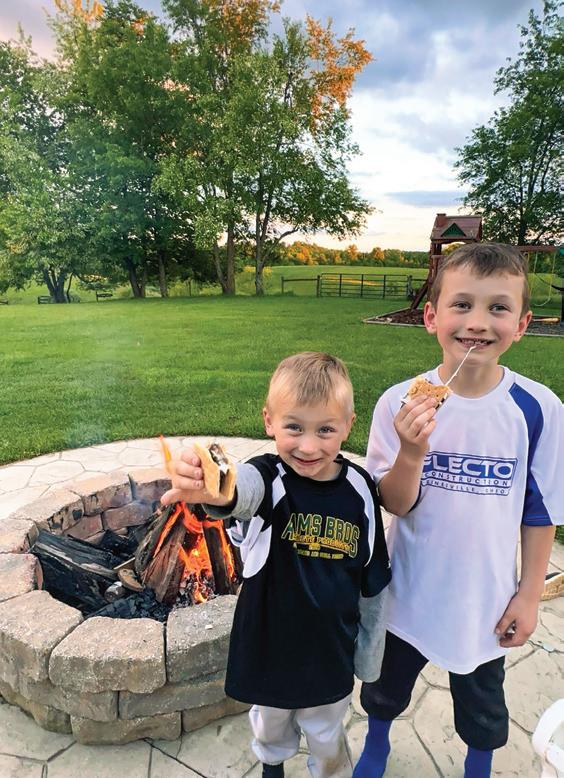
SEP. 19–21 – “Who Was Baron von Steuben?” Historic Fort Steuben, 120 S. 3rd St., Steubenville. Free. Exhibits and programs on the Drillmaster of the American Revolution; free; for information call 740-283-1787 or www. oldfortsteuben.com.
SEP. 20 – Big Band Gatsby Dance, Vermilion VFW Hall, 7576 Poorman Rd., Vermilion. $25 per person; $45 per couple. Doors open at 4:30 p.m.; dance till 8 p.m. Waltz, foxtrot, swing, line dance, and more to big band sounds of the Vermilion Windjammers Big Band. Gatsby theme; dress for the era or as you like. Food and spirits available. 419-929-1114 (landline) or www. facebook.com/UsaDanceSanduskyChapter2094
OCT. 3–4 – Sinister Horror Fest, Skyway Twin DriveIn Theatre, 1825 N Leavitt Rd. NW, Warren. Halloween and horror-themed vendors, laser tag, special guests, trick or treat, pumpkin carving, horror films, and more. Free admission Sat. 12–5 p.m. Two screens of triple features each night! https://trulytrumbull.com/events/ sinister-horror-fest-2025
THROUGH OCT. 11 – “Quilts Galore!” Exhibit, McCook House Museum, 15 Public Square, Carrollton, Fri./Sat. 10 a.m.–5 p.m. Adults $5, children $3. Come see the plethora of talent our rural Carroll County has to offer. Enjoy the stories that accompany each hand-sewn and machine-made entry. 330-437-9715 or kathorn4120@gmail.com.
THROUGH OCT. 31 – “Trails of Immersion” Art Exhibition, Cleveland Botanical Garden/Holden Forests and Gardens, 11030 East Blvd., Cleveland. Featuring landscape artist Jennifer Sowders. Enjoy this exhibition as part of your day at the gardens, where admission is $20 for nonmembers, free for members. https://holdenfg.org/attractions/clevelandbotanical-garden/art-galleries.
SEP. 8–21 – “Celebrate the Constitution,” Historic Fort Steuben, 120 S. 3rd St., Steubenville, Mon.–Sat. 10 a.m.–4 p.m., Sun. 11 a.m.–4 p.m. Free. Annual exhibit and activities focusing on the nation’s founding document and the issues and personalities of the time. 740-283-1787 or www.oldfortsteuben.com.
SEP. 16 – Josee McGee and Jackson Boling, Canal Fulton Public Library, 154 Market St. NE, Canal Fulton, 6:30–7:30 p.m. Free. The duo will perform classic (and should-be-classic) tunes from a variety of eras and genres using thoughtful guitar and vocal arrangements. Seating on a first-come, first-served basis. 419-853-6016 or www.ormaco.org.
SEP. 19 – Civil War School Day, Historic Zoar Village, 198 Main St., Zoar, 11 a.m. – 4 p.m. $10 Open to all public, private, and homeschooled students. Learn about life on the Civil War battlefield and meet a variety of Civil War legends. Cavalry and artillery demos and other hands-on activities. Reservations requested. 330-874-3011 or www.historiczoarvillage.com.
SEP. 20 – Oktoberfest on the Square, downtown Warren, 4–8 p.m. Grape-stomping competition, kids’ activities, German-inspired food, music, and more than 12 different types of beers from local breweries. 330-394-4653 or https://trulytrumbull.com/events.
SEP. 20–21 – Civil War Encampment, Historic Zoar Village, 198 Main St., Zoar, 11 a.m.–4 p.m. $12; 12 and under free. Ohio’s largest Civil War reenactment returns with a re-creation of the Battle of Appomattox. Civil War Ball, historical demonstrations, and reenactors portraying key historical Civil War figures. 330-874-3011 or www.historiczoarvillage.com.
SEP. 20–21 – Kuchta Farms Fall Fest, 4765 OH-82, Newton Falls, 10 a.m.–5 p.m. Specialty vendors, food, live music, corn maze, wagon ride, and more. 330984-4525 or https://trulytrumbull.com/events.
SEP. 21 – Fallfest, Lake Mohawk, 1 N. Mohawk Dr., Malvern, 11 a.m.–5 p.m. Free admission/parking. Artisans, skilled craftsmen, ATVs, water-ski show, boat show, kids’ activities, German-style bier garden, fantastic food, and more. www.lake-mohawk.org.
SEP. 27, OCT. 4 – Eagle Hollow Presents Sleepy Hollow, Greene Eagle Winery, 2576 Davis Peck Rd., Cortland. $5. Relive the Legend of Sleepy Hollow and see the Headless Horseman ride again! Arrive by 5:30 p.m. to ensure you see all the performances. For more details: 330-583-9463 or https:// trulytrumbull.com/events.
OCT. 3 – First Fridays on Fourth, 155 N. 4th St., Steubenville, 6–10 p.m. Free. Oktoberfest celebration featuring art, crafts, games, food trucks, live entertainment, and more. www.theharmoniumproject. org/first-Fridays.
SEP. 25–28 – Preston County Buckwheat Festival, 115 Brown Ave., Kingwood. Buckwheat cakes and sausage dinners served all day. Parades, car show, livestock shows and competitions, carnival rides, art and crafts, concerts, and more. https:// buckwheatfestival.com.
OCT. 4 – Apple Butter Day, Fort New Salem, 81 Settlers Lane, Salem. We will be making apple butter on-site. 304-695-2220, director@ fortnewsalemfoundation.org, or www. fortnewsalemfoundation.org.
OCT. 4 – Descendant’s Day, Historic Zoar Village, 198 Main St., Zoar, 1–4 p.m. Lively community celebration honoring the historical heritage of the Zoar community. Descendants can enjoy guided tours of the historic buildings, including the Bimeler Cabin, and opportunities to connect with family members and fellow history enthusiasts. 330-874-3011 or www. historiczoarvillage.com.
OCT. 4 – Free Speaker Series: Katharina von Baron Luther Presentation, Historic Zoar Village, Zoar School House, 198 Main St., Zoar, 11 a.m.–1 p.m. Raylene Hlavaty will be presenting a first-person narrative of the life of Katharina von Baron Luther, the wife of Martin Luther. Open to the public with free parking near the School House. 330-874-3011 or www.historiczoarvillage.com.
OCT. 4 – Wayne County Stitchers Sewing Fest, Church of the Cross, 5100 Cleveland Rd., Wooster, 9 a.m.–3 p.m. No registration; $10 admission. A fun day of creative learning, including classes, door prizes, raffle, boutique, and fabric fair. For more information, email rcschade13@gmail.com or follow us on Facebook.
OCT. 4–5 – Three Sisters Intertribal Pow Wow, Atwood Lake Fall Festival, 9500 Lakeview Rd., Mineral City, Sat. 10 a.m.–9 p.m., Sun. 10 a.m.–5 p.m. A familyfriendly weekend of Native American music, dancing, storytelling, cultural exchange, and celebration of heritage. Grand entry at noon both days. Glow dance at 7:30 p.m. (or dark). 330-771-2531 (Ronda), threesistersintertribal@gmail.com, or www.facebook. com/threesistersintertribal?mibextid=ZbWKwL
OCT. 12 – “Music from Anansi’s Web: Exploring the Cultural Threads That Connect Us,” Wadsworth Public Library, 132 Broad St., Wadsworth, 2–3 p.m. World percussionist Daniel Shiller will perform music inspired by the stories of the folklore character Anansi the spider, the keeper of all the world’s stories. Seating will be on a first-come, first-served basis. 419853-6016 or www.ormaco.org.
SEP. 13 – Walk to End Alzheimer’s, Zane State College, 1555 Newark Rd., Zanesville, 8:30 a.m. For questions, please visit www.facebook.com/ share/g/162GdiFTwd or https://act.alz.org/site/TR/ Walk2025/OH-CentralOhio?fr_id=18808&pg=entry.
SEP. 13–14 – Harvest Celebration, Smeck Park, 7395 Basil Rd, Baltimore, 11 a.m.–4 p.m. Free. Watch members of Fairfield County Antique Tractor Club bring in the crops using early farm machinery. Games and activities for all ages, demonstrations, displays, vendors, music, food trucks, and more. www.fairfieldcountyparks.org/events.
blues. Enjoy one last night of music, food, and fun on the Blacktop! www.pickaway.com.
SEP. 26–27 – The Country Shop Hop, various businesses in the Amanda, Tarlton, and Stoutsville area. Enjoy a ride in the country to shop for fall treasures, vintage finds, good food, and so much more. Join our scavenger hunt to gather entries into our drawing for “shop hop bucks.” For more details, call/text 740-207-1808 or visit www. countryshophop.com.
THROUGH OCT. 3 – First Friday Car Show, 122 N. Court St., Circleville, 5–9 p.m. Enjoy a night of classic cars, community fun, and a vibrant uptown atmosphere. All cars are welcome! www.pickaway.com.
THROUGH OCT. 25 – Coshocton Farmers Market, Skip’s Landing, 22375 Co. Rd. 1A, Coshocton, Sat. 8:30 a.m.–noon. Locally grown produce, baked goods, and artisan crafts. Rain or shine. www. facebook.com/coshoctonfarmersmarket or email market.manager@coshfarmmarket.org.
SEP. 5, OCT. 3 – First Friday Art Walk, downtown Zanesville, 5–8 p.m. Come downtown on the first Friday of each month, when all our participating galleries, studios, and small businesses are open at the same time! See our website for a map of current participants: https://artcoz.org/arts-district-map.
THROUGH NOV. 27 – Athens Farmers Market, Athens Community Center, 701 E. State St., Athens, Wed. 9 a.m.–noon. Open year-round Sat. 9 a.m.–noon. 740-593-6763, www.athensfarmersmarket. org, or www.facebook.com/afm.ohio.
SEP. 10–11 – NARO Ohio Convention, Pritchard Laughlin Center, 7033 Glenn Hwy., Cambridge. At the annual meeting of the National Association of Royalty Owners, Ohio Chapter, hear from an exciting lineup of speakers across the industry and learn more about mineral ownership, royalties, legislation, technology, economics, and most of all, opportunities! Discount on introductory membership (discount code: GROW.2025): https:// join-naro.org/membership. For registration and information, visit https://naroohio.org.
SEP. 18–NOV. 6 – Exhibitions at the MAC, Peggy R. McConnell Arts Center, 777 Evening St., Worthington. Free. Three exhibitions will be on display: Quantifying Care by Lily Glass, Intertwined by Margarita Vilshanetskaya, and Power of Growth by Weiting Wei. www.mcconnellarts.org.
SEP. 19–20 – Pickerington Oktoberfest, Combustion Brewery and Taproom, 80 W. Church St., Pickerington, Fri. 3–10 p.m., Sat. 12–10 p.m. Free admission. Live entertainment including music, contests, games, food, and of course a beer garden featuring craft beers, cider, and wine. Beer Mile Run Sat. 10 a.m.–12:30 p.m. 614-382-2452 or www.pickeringtonvillage.com/events.
SEP. 20 – Boogie on the Blacktop: Gypsy Kyngs, 135 E. Main St., Circleville, 6–11 p.m. Close out the summer concert series with powerful rock and
SEP. 27–28 – Frontier Spirit 1799, Alley Park, 2805 Old Logan Rd. SE, Lancaster, 10 a.m.–5 p.m. Free. Step back in time to see what life was like for the first settlers in the Ohio Territory, featuring characters from early Fairfield County. Demonstrations by skilled craftsmen, period music, games and activities for children, and much more. Concessions available at reasonable prices. www. frontierspirit.org.
SEP. 28 – Marysville Toy Show, Union Co. Fgds., 845 N. Main St., Marysville, 9 a.m.–3 p.m. $6; 12 and under free; early buyer (8–9 a.m.) $12. Buy, sell, and trade vintage and new toys. 614-206-3455 or www.marysvilletoyshow.com.
OCT. 11 – Grandma Gatewood Fall Color Hike, Hocking Hills State Park, 19852 St. Rte. 664 S., Logan, 9 a.m. A strenuous hike that spans 6 miles on the Grandma Gatewood trail from Old Man’s Cave to Cedar Falls and back. Dress for the fall weather and terrain. Meet at the Visitor Center. 740-385-6841 or www.thehockinghills.org/Events.htm.
SEP. 19 – German Heritage Day, Ross County Heritage Center, 45 W. Fifth St., Chillicothe, 11 a.m.–7 p.m. Free admission. Schmidt’s Sausage Truck returns to Chillicothe, so stop by for a cream puff and stay for some German-heritage entertainment and history. www.rosscountyhistorical.org.
SEP. 19–21 – Downtown Fall Open House, Chillicothe, all day. Celebrate the season with sidewalk sales, fall treats, and a sip-and-stroll through your favorite local shops and eateries. www.downtownchillicothe.com.
SEP. 20 – Fall Festival, downtown Cambridge, 10 a.m.–6 p.m. Free. Over 50 arts and crafts vendors, live entertainment, food trucks, children’s games and activities, and more. Enjoy a day of family fun! www.downtowncambridge.com.
SEP. 20 – Ghost Walk, downtown Chillicothe, 45 E. Second St., Chillicothe, 10 a.m.–6 p.m. $10 Tour five downtown locations where you will hear the stories of their history along with the ghostly encounters that have been experienced. www. chillicothehalloweenfestival.com.
SEP. 20 – Oktoberfest, Majestic Theatre Courtyard, 45 E. Second St., Chillicothe, 3–10 p.m. $5; $3 if dressed in German clothing. Enjoy traditional German fare and beer, wiener dog races, beer chugging, yodeling, and stein holding contest; a kids’ station with face painting, hair braiding, and other kids’ things. www.downtownchillicothe.com.
SEP. 20–21 – Apple Harvest Open House, Hirsch Fruit Farm, 12846 OH-772, Chillicothe, Sat. 9 a.m.–6 p.m., Sun. 12–6 p.m. $5. Experience farm fun for the whole family with orchard tours, pick-your-own apples, a pumpkin patch, food, and exciting activities like slides, horse rides, and more! www.downtownchillicothe.com.
SEP. 27 – Harvest Day, Scioto Trail State Park, 144 Lake Rd., Chillicothe, 9 a.m. Free. Family fun, food, games, petting zoo, and more at the campgrounds. www.downtownchillicothe.com.
SEP. 27–28 – John Roger Simon Sorghum Festival, 8721 Careys Run Pond Creek Rd., Portsmouth, 10 a.m.–4 p.m. Free. Celebrate Appalachian folk art and music. Jamming with old-time musicians, Appalachian music history, and artisans demonstrating rural heritage crafts like corn husk dolls, wheat weaving, quilting, and more. Food and sweet sorghum treats will be available to purchase. 937-365-1935 or www.arcofappalachia.org.
OCT. 11–12 – Washington County Fair Fall Festival, Washington Co. Fgds., 922 Front St., Marietta, Sat. 11 a.m.–7 p.m. ($10), Sun. 9 a.m.–1 p.m. ($5). Apple cider making, wagon rides, pumpkin patch, petting zoo, kids’ activities, live music, food trucks, and more! Open-fire chicken dinner Sat. 4:30–7 p.m.; car show, tractor and engine show on Sunday. 740-516-6877 (Lisa McNish) or www.washcountyfair.com/fall-festival.
THROUGH OCT. 11 – The Great Sidney Farmer’s Market, 109 S. Ohio Ave., every Sat. 8 a.m.–noon. Vendors from all around the area provide great food, crafts, and more. 937-658-6945 or www.facebook. com/sidneyfarmersmarketoh.
SEP. 3, OCT. 1 – Down on the Farm Story Time, Proving Ground Farm, 5670 E. Twp. Rd. 138, Tiffin, 10 a.m. Stories and activities geared for preschool-age children that focus on farming and nature. Families welcome! 419-447-7073, www.conservesenecacounty. com, or Seneca Conservation District on Facebook.
SEP. 6–7, OCT. 11–12 – Bucyrus Flea Market, Crawford Co. Fgds., 610 Whetstone St., Bucyrus, 9 a.m.–3 p.m. Free admission. 419-569-7008 (David M. Staats) or www.crawfordcofair.com/annual-events.
SEP. 11–14 – Delphos Canal Days and Parade, downtown Delphos, Fri. 4 p.m.–midnight, Sat. 10 a.m.–midnight, Sun. 10 a.m.–6 p.m. Free admission. Official kick-off on Thursday with the Toast to the City. Musical entertainment, rides, games, 5K, food, and much more! Grand Parade Sun. 2 p.m., followed by grand prize drawing. https://delphoscanaldays.com.
SEP. 13 – Lima Area Concert Band: “Heroes and Villains,” Veterans Memorial Civic and Convention Center, #7 Town Square, Lima, 7:30 p.m. $15; students free. Heroes and villains throughout history are often recognized by the music that introduces them. This concert will present some of the popular themes of these characters. https://limaareaconcertband.org.
THROUGH OCT. 27 – Rib City BBQ & Bluegrass, 746 NW Washington Blvd., Hamilton, Mon. 7–9 p.m. Free admission. Enjoy an evening of lively bluegrass music by Vernon McIntyre’s Appalachian Grass. Call 513-8297427 before traveling.
THROUGH OCT. 29 – Bluegrass Wednesdays, Vinoklet Winery, 11069 Colerain Ave., Cincinnati, Wed. 6:30–8:30 p.m. Enjoy dinner, wine, and an evening of free entertainment by Vernon McIntyre’s Appalachian Grass. Reservations recommended. 513-385-9309, vinokletwinery@fuse.net, or www.vinokletwines.com.
THROUGH NOV. 30 – Pumpkin Blow, Neusole Glassworks, 11925 Kemper Springs Dr., Cincinnati,
SEP. 20–21 – Findlay Flea Market, Hancock Co. Fgds., 1017 E. Sandusky St., Findlay, Sat. 9 a.m.–4 p.m., Sun. 9 a.m.–3 p.m. Free admission. New, used, and vintage items, crafts, and more. Food trucks onsite. Vendors welcome! For more information, contact Christine at 419-619-0041 or futrellcg1@gmail.com or find us on Facebook.
SEP. 20–OCT. 19 – NWORRP Pumpkin Train, 12505 Co. Rd. 99, Findlay, Sat./Sun. 1–5 p.m. $3; 12 and under, $2. Ride our quarter-scale train to the pumpkin patch to find that special pumpkin, load it on the train’s flatcar, and take one more trip around the track to return to the station. Be sure to enjoy the games, decorations, and family-friendly activities throughout the museum during your visit. 419-423-2995, www. facebook.com/nworrp, or www.nworrp.org.
SEP. 21 – The King Car and Motorcycle Show, Faurot Park Pavilion, 598 S. Jameson Ave., Lima, 12–5 p.m. Registration 12–2 p.m. ($20); includes a T-shirt. 14 trophies, 30 plaques, and a student category. Raffles, door prizes, trolley rides, free entertainment, and fun for the whole family! www.facebook.com/ thekingcarshow.
SEP. 25–27 – Van Wert Bluegrass Festival, Van Wert Fgds., 1055 S. Washington St., Van Wert. Enjoy a whole weekend of bluegrass music with jamming, stage shows, vendors, good food, and lots of camaraderie. Two shows by Vernon McIntyre’s Appalachian Grass on Saturday the 27th! 419-5942816 (Steve Scott) or www.vanwertcountyfair.com/ events-on-the-grounds.
SEP. 26 – Sky Fishing at Kendrick Woods, 971 N. Defiance Trail, Spencerville, 9–11 p.m. A naturalist will set up equipment to go “sky fishing,” a way that scientists sample the insects flying through our night sky. Help us identify and record the insects we find, or simply enjoy the show! Event starts at sunset. Register by calling 419-221-1232
SEP. 26–OCT. 19 – NWORRP Halloween Express, 12505 Co. Rd. 99, Findlay, Fri./Sat. 6:30–9 p.m. $3; 12 and under, $2. Take the whole family on a non-scary Halloween train ride around our tracks to see the Halloween decorations after dark. 419-423-2995,
Wed./Thur. 10 a.m.–6 p.m., Fri.–Sun. 10 a.m.–8 p.m. (except for Thanksgiving Day). $55 per 30-minute session. Must be age 5 or older. Make your own blown-glass pumpkin from hot molten glass! Reservations required. 513-751-3292 or neusoleglassworks@hotmail.com.
SEP. 12 – Bluegrass Night, Fibonacci Brewing Company, 1445 Compton Rd., Cincinnati, 7–9 p.m. Free. Enjoy lively bluegrass music by Vernon McIntyre’s Appalachian Grass, a wide variety of craft beers at the Beer Garden, and food truck eats. 513832-1422 or http://fibbrew.com.
SEP. 20 – Vernon McIntyre’s Appalachian Grass, Sterling Bluegrass Jamboree, 29 E. Main St., Mt. Sterling, 7 p.m. Enjoy lively bluegrass music with lightning-fast instrumentals, close harmonies, and entertaining novelty songs. Music kicks off at 6 p.m. with the Sterling Bluegrass Band. Home-cooked food and pies available on-site. 614-323-6938 or www. sterlingbluegrassjamboree.com/upcoming-events.
SEP. 20 – “Uncle Tom’s Cabin: An American Classic,” New Madison Public Library, 142 S. Main St., New Madison, 11 a.m. Free. Dr. John Getz, with the Harriet Beecher Stowe House, will discuss how an 1852 novel is controversial then and now. Reservations recommended. 937-9961741, info@newmadisonpubliclibrary.org, or www. mynmpl.org.
www.facebook.com/nworrp, or www.nworrp.org.
SEP. 27 – Swiss Community Historical Society Fall Festival, Schumacher Homestead, 8350 Bixel Rd., Bluffton, 10 a.m.–3 p.m. Free admission; donation only. Home, garden, workshop, summer kitchen, and barn tours; children’s games, straw maze, farm animal petting zoo, and more. Enjoy soup from the kettle, bread from the bake oven, cheese, cider, fire-popped popcorn, and musical entertainment. 419-358-1049 or glwetherill@gmail.com.
OCT. 3–5 – Findlay Fall Harvest Festival, Northwest Ohio Railroad Preservation Inc., 12505 Co. Rd. 99, Findlay, Fri./Sat. 9 a.m.–9 p.m., Sun. noon–5 p.m. $5. Family-friendly games and activities, live entertainment, bounce houses, corn cannons, train rides, and pumpkin chuckin’ all day long. The Tracks to the Past Machinery Show will feature antique steam engines, gas engines, tractors, doodle bugs, and much more. 419-423-2995, www.nworrp.org, or www. facebook.com/nworrp.
OCT. 3–5 – Johnny Appleseed Festival Antique Tractor Show, Fun Pull, and Flea Market, Auglaize Village, 12296 Krouse Rd., Defiance. $5; 12 and under free. In addition to our regular activities, we will be making apple cider, sorghum molasses, and kettle corn; sawing up timber at the sawmill; and offering train rides on the Village railroad ($2). School Day on Friday, Oct. 3 419-990-0107, villageauglaize@gmail. com, or www.auglaizevillage.com.
OCT. 11 – Lima Symphony: “Symphonic Landscapes,” Veterans Memorial Civic and Convention Center, #7 Town Square, Lima, 7:30 p.m. Prepare to be swept away on an extraordinary journey through the natural world brought to life with stunning visual projections and symphonic masterpieces. www. limaciviccenter.com.
OCT. 11 – Van Buren Fall Festival, Van Buren High School, 217 S. Main St., Van Buren, 9 a.m.–3 p.m. Sponsored by the Van Buren Lions Club. Homemade apple butter, bean soup cooked over an open fire, food vendors, a craft show, community garage sales, and a kids’ area. Come join the fun! 419-889-8796 or vanburenapplebutter@yahoo.com.
SEP. 20–21 – Preble County Pork Festival, Preble Co. Fgds., 722 S. Franklin St., Eaton, Sat. 8 a.m.–8 p.m., Sun. 8 a.m.–5 p.m. Free admission/parking. Parade Sat. 10:30 a.m. The best pork chops, pulled pork, ham sandwiches, and sausage in the region. www.porkfestival.org.
OCT. 4 – “Passport to the Past,” White Water Shaker Village, 11813 Oxford Rd., Harrison, 2–5 p.m. Free. Open house held in conjunction with local historical sites, such as Harrison Village Historical Society Museum, Othneil Looker House, Fernald Feed Materials Feed Production Center (Fernald Preserve), and Passmore Cabin. www.whitewatervillage.org
OCT. 7–11 – Bradford Pumpkin Show, downtown Bradford. Free admission. Parades, concessions, rides, and contests. Bake-A-Pumpkin Pie and Cookie Contest on Wednesday. Car show and Smash-APumpkin on Saturday. For full schedule, visit www. bradfordpumpkinshow.org.
OCT. 12–13 – Ohio Sauerkraut Festival, Historic Main Street, Waynesville, Sat. 9 a.m.–8 p.m., Sun. 9 a.m.–6 p.m. Sample homemade sauerkraut and many kraut-containing foods; non-kraut foods also available. Approx. 460 craft vendors from over 25 states will be selling their handmade goods. 513-897-8855 or https://sauerkrautfestival.waynesvilleohio.com.

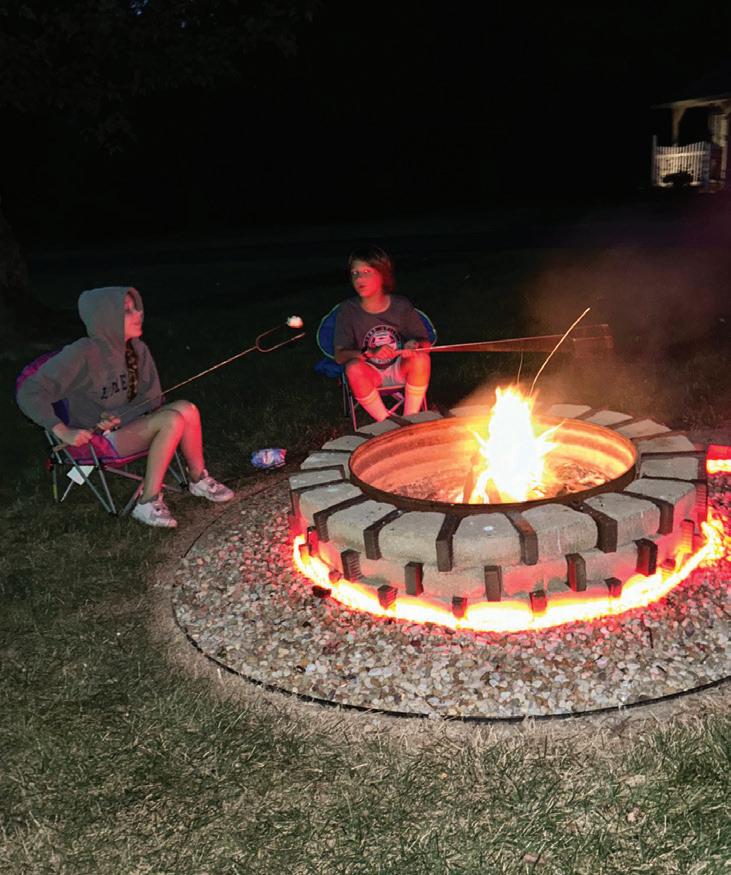
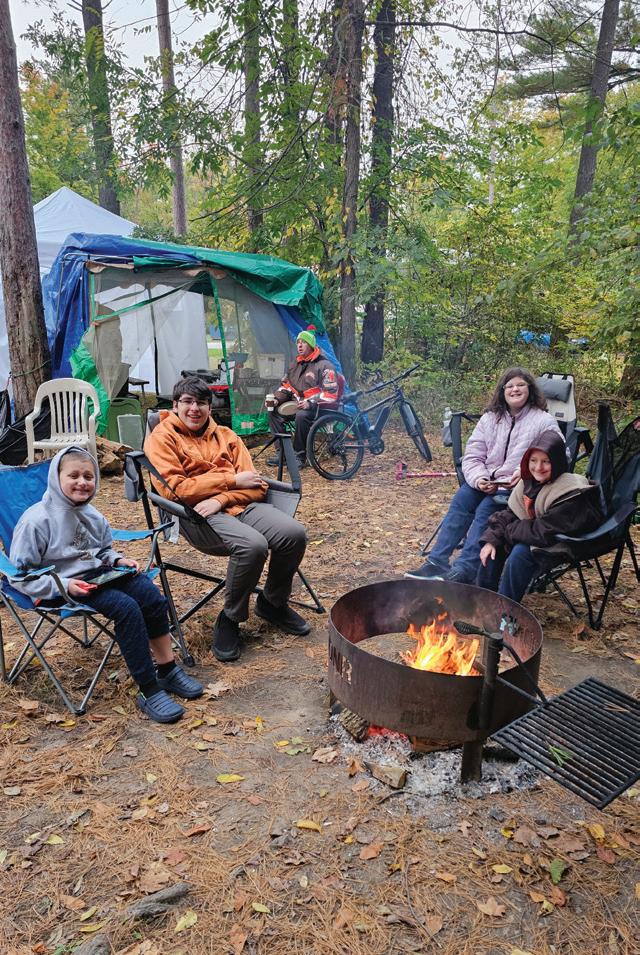

6. My boys, Leland and Waylen Gallatin, enjoying s’mores by the campfire. ~ Christina Gallatin, Lorain-Medina Rural Electric Cooperative member 1 4 2 5 3 6
3. Our daughter, Aeva, enjoying a s’more. ~ Brittany Weaver, Carroll Electric Cooperative member
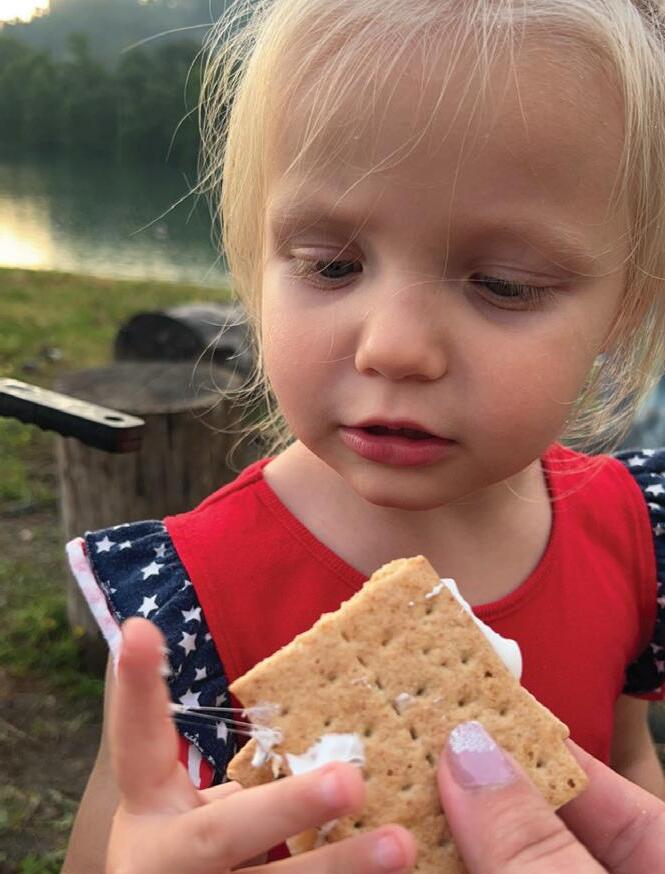

4. Camping at Findley State Park with our grandchildren, Will, Erin, Xavier, and Killian, and our son, Joe. ~ Marlene Shivaksh, Lorain-Medina Rural Electric Cooperative member
5. My daughter, Amanda, with her kids, Jayden, Camden, and Alizah. Their treat was breakfast bacon. ~ Katie Grubba, South Central Power Company member
Send us YOUR picture! For December, send “Snow scenes” by September 15; for January, send “Bedtime routine” by October 15. Upload your photos at www.ohioec.org/memberinteractive, and remember to include your co-op name and to identify everyone in your photos.
Simply fill out this form and drop it off at the Ohio's Electric Cooperatives Education Center on Wheat Street during the 2025 Farm Science Review.
Name:

When you attend the Farm Science Review this year, make sure to visit the NEW Ohio’s Electric Cooperatives Education Center on Wheat Street to find exhibits, energysaving tips, demonstrations... and free popcorn!





